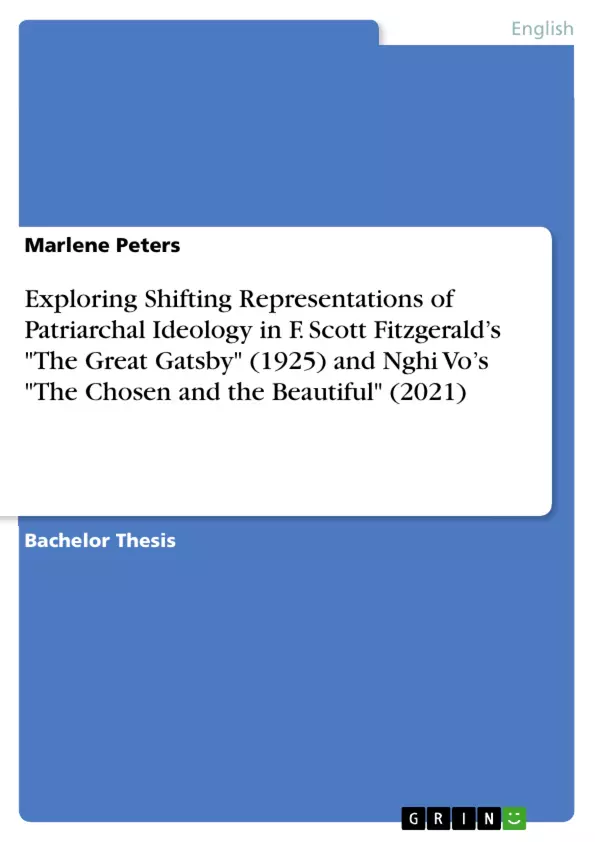The following bachelor thesis deals with patriarchal representations in Fitzgerald's "The Great Gatsby" (1925) and compares them with a contemporary representation "The Chosen and the Beautiful" by Nghi Vo (2021). Themes such as masculinity, femininity and LGBTQA+ are explored along the characters and a comparison is made between the past and present.
This thesis presents the context of the two main works first. To contextualize The Great Gatsby (1925), it looks at the historical context of America in the 1920s, issues of race in U.S. national culture and views on gender, patriarchy and queering in the Jazz Age. To provide a context for The Chosen and The Beautiful (2021), it highlights what social movements have taken place in order to understand how the topic of gender is viewed today.
Since The Chosen and The Beautiful is a retelling of The Great Gatsby, the rewrite as a genre and its function will be examined. The next chapter explores concepts, ideas and developments of Feminist Literary Theory, Queer Theory and Intersectionality Theory. The fourth chapter then analyzes both primary texts in comparison along gendered themes: Masculinity, femininity and queer characters are examined by changing the perspective from a male to a female point of view. The concluding chapter presents the findings.
Table of Contents
- Introduction
- Contextualising F. Scott Fitzgerald's The Great Gatsby (1925) and Nghi Vo's The Chosen and the Beautiful (2021)
- Feminist Literary Theory and Queer Theory: Concepts, Ideas and Developments
- Patriarchal and Gender Representations in The Great Gatsby (1925) and The Chosen and the Beautiful (2021)
- Masculinity
- Femininity
- Queer Characters and Places
- Conclusion
Objectives and Key Themes
This thesis aims to analyze the changing representations of patriarchal ideology in F. Scott Fitzgerald's The Great Gatsby (1925) and Nghi Vo's The Chosen and The Beautiful (2021). It will explore how the two novels present different perspectives on gender roles, stereotypes, and power dynamics, highlighting how these issues are reflected in the historical and social contexts of each work.
- Patriarchal ideology and its impact on gender roles
- The portrayal of masculinity and femininity in both novels
- The representation of queer characters and their experiences
- The significance of the rewrite as a genre and its ability to challenge existing narratives
- The influence of historical and social contexts on the representations of gender and patriarchy
Chapter Summaries
The first chapter introduces the two primary texts, The Great Gatsby and The Chosen and The Beautiful, and their respective contexts. It discusses the historical backdrop of 1920s America, focusing on racial issues and the emergence of the "New Woman." The chapter also examines the social movements and cultural changes that have shaped contemporary understandings of gender.
Chapter two explores the theoretical frameworks of Feminist Literary Theory, Queer Theory, and Intersectionality Theory, providing essential concepts and ideas for analyzing the texts.
The third chapter dives into the representations of masculinity, femininity, and queer characters in both The Great Gatsby and The Chosen and The Beautiful. It analyzes how each text presents different perspectives on these topics and the influence of patriarchal ideology on their portrayal.
Keywords
Key terms and concepts discussed in this thesis include patriarchal ideology, gender roles, stereotypes, masculinity, femininity, queer characters, The Great Gatsby, The Chosen and The Beautiful, feminist literary theory, queer theory, intersectionality theory, historical context, social movements, and the rewrite as a genre.
- Quote paper
- Marlene Peters (Author), 2023, Exploring Shifting Representations of Patriarchal Ideology in F. Scott Fitzgerald’s "The Great Gatsby" (1925) and Nghi Vo’s "The Chosen and the Beautiful" (2021), Munich, GRIN Verlag, https://www.grin.com/document/1495999



